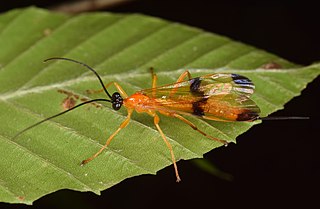
The Ichneumonidae, also known as the ichneumon wasps, Darwin wasps, or ichneumonids, are a family of parasitoid wasps of the insect order Hymenoptera. They are one of the most diverse groups within the Hymenoptera with roughly 25,000 species currently described. However, this likely represents less than a quarter of their true richness as reliable estimates are lacking, along with much of the most basic knowledge about their ecology, distribution, and evolution. Ichneumonid wasps, with very few exceptions, attack the immature stages of holometabolous insects and spiders, eventually killing their hosts. They thus fulfill an important role as regulators of insect populations, both in natural and semi-natural systems, making them promising agents for biological control.
The metathorax is the posterior of the three segments in the thorax of an insect, and bears the third pair of legs. Its principal sclerites are the metanotum (dorsal), the metasternum (ventral), and the metapleuron (lateral) on each side. The metathorax is the segment that bears the hindwings in most winged insects, though sometimes these may be reduced or modified, as in the flies (Diptera), in which they are reduced to form halteres, or flightless, as in beetles (Coleoptera), in which they may be completely absent even though forewings are still present. All adult insects possess legs on the metathorax. In most groups of insects, the metanotum is reduced relative to the mesonotum. In the suborder Apocrita of the Hymenoptera, the first abdominal segment is fused to the metathorax, and is then called the propodeum.

The mesosoma is the middle part of the body, or tagma, of arthropods whose body is composed of three parts, the other two being the prosoma and the metasoma. It bears the legs, and, in the case of winged insects, the wings.

The Aulacidae are a small, cosmopolitan family of wasps, with two extant genera containing some 200 known species. They are primarily endoparasitoids of wood wasps (Xiphydriidae) and xylophagous beetles. They are closely related to the family Gasteruptiidae, sharing the feature of having the first and second metasomal tergites fused, and having the head on a long pronotal "neck", though they are not nearly as slender and elongate as gasteruptiids, nor are their hind legs club-like, and they have more sculptured thoraces. They share the evanioid trait of having the metasoma attached very high above the hind coxae on the propodeum.

Campopleginae is a large subfamily of the parasitoid wasp family Ichneumonidae with a world-wide distribution. Species in this subfamily have been used in the biological control of the alfalfa weevil, clover weevil, various species of Heliothis, oriental army worm, European corn borer, larch sawfly, and others.

Nesagapostemon is an extinct monotypic genus of sweat bee in the Halictidae subfamily Halictinae. At present, it contains the single species Nesagapostemon moronei.
Eickwortapis is an extinct monotypic genus of sweat bee in the Halictidae subfamily Halictinae which contains the single species Eickwortapis dominicana.
Aphaenogaster praerelicta is an extinct species of ant in the subfamily Myrmicinae known from a solitary Late Oligocene to Early Miocene fossil found in Mexico. At the time of description A. praerelicta was one of three Aphaenogaster species known from Mexico.

Anomalon is a large genus of parasitoid wasps belonging to the family Ichneumonidae. This may be the only genus in the tribe Anomalonini, although Neogreeneia Viereck, 1912 is sometimes considered a valid genus of the tribe.

Acrotaphus is a genus of ichneumon wasps in the family Ichneumonidae. There are about 26 described species in Acrotaphus. They are parasitoids of Araneidae and Tetragnathidae spider families.

Hymenoepimecis is a genus of parasitoid wasps belonging to the family Ichneumonidae best known for parasitizing arachnids, specifically those of the families Araneidae and Tetragnathidae.
Habronyx fulvipes is a species of parasitic ichneumon wasp. It was renamed by Townes, Momoi and Townes in 1965 ; prior to that the species had been named Habronyx chinensis, chinensis meaning "China", in 1955 by Japanese entomologist Toichi Uchida. The holotype and allotype were collected by R. Mell. The species was first named Exochilum Chinense by Morley in 1913.
Dusona admontina is a species of parasitic wasp belonging to the family Ichneumonidae, subfamily Campopleginae. It is a parasitoid of the larvae of Herminia grisealis.
Dusona abdominator is a species of parasitic wasp belonging to the family Ichneumonidae, subfamily Campopleginae.
Dusona aemula is a species of parasitic wasp belonging to the family Ichneumonidae, subfamily Campopleginae. It is a parasitoid of Geometrid moth larvae, mainly Eupithecia species.
Dusona juvenilis is a species of parasitic wasp belonging to the family Ichneumonidae, subfamily Campopleginae. It is a parasitoid of Eupithecia haworthiata larvae.

Dusona leptogaster is a species of parasitic wasp belonging to the family Ichneumonidae, subfamily Campopleginae. It is a parasitoid of Geometrid moth larvae, the two known hosts being Alsophila aescularia and Lomaspilis marginata.
Dusona nidulator is a species of parasitic wasp belonging to the family Ichneumonidae, subfamily Campopleginae. It is a parasitoid, but the host is unknown.
Dusona terebrator is a species of parasitic wasp belonging to the family Ichneumonidae, subfamily Campopleginae. It is a parasitoid of Noctuid moth larvae.

Callidora is a genus of parasitoid wasps belonging to the family Ichneumonidae and the subfamily Campopleginae. It is relatively species poor, with only five recognized species.









